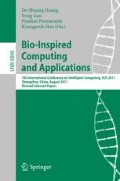Abstract
Inversion of Rayleigh wave dispersion curves not only undergoes computational difficulties associated with being trapped by local minima for most local-search methods but also suffers from the high computational time for most global optimization methods due to its multimodality and its high nonlinearity. In order to effectively overcome the above described difficulties, we proposed a new Rayleigh wave inversion scheme based on an ant colony optimization, a commonly used swarm intelligence algorithm. The calculation efficiency and stability of the proposed procedure are tested on a five-layer synthetic model and a real-world example. Results from both synthetic and real field data demonstrate that ant colony optimization applied to nonlinear inversion of Rayleigh waves should be considered good not only in terms of computation time but also in terms of accuracy due to its global and fast convergence in the final stage of exploration.
Access this chapter
Tax calculation will be finalised at checkout
Purchases are for personal use only
Preview
Unable to display preview. Download preview PDF.
References
Park, C.B., Miller, R.D., Xia, J.: Multichannel analysis of surface waves. Geophysics 64, 800–808 (1999)
Song, X., Gu, H., Liu, J., Zhang, X.: Estimation of shallow subsurface shear-wave velocity by inverting fundamental and higher-mode Rayleigh waves. Soil Dynamics and Earthquake Engineering 27(7), 599–607 (2007)
Song, X., Gu, H.: Utilization of multimode surface wave dispersion for characterizing roadbed structure. Journal of Applied Geophysics 63(2), 59–67 (2007)
Song, X., Gu, H., Zhang, X., Liu, J.: Pattern search algorithms for nonlinear inversion of high-frequency Rayleigh wave dispersion curves. Computers & Geosciences 34(6), 611–624 (2008)
Song, X., Li, D., Gu, H., Liao, Y., Ren, D.: Insights into performance of pattern search algorithms for high-frequency surface wave analysis. Computers & Geosciences 35(8), 1603–1619 (2009)
Yamanaka, H., Ishida, H.: Application of genetic algorithm to an inversion of surface wave dispersion data. Bulletin of the Seismological Society of America 86, 436–444 (1996)
Beaty, K.S., Schmitt, D.R., Sacchi, M.: Simulated annealing inversion of multimode Rayleigh-wave dispersion curves for geological structure. Geophysical Journal International 151, 622–631 (2002)
Shirazi, H., Abdallah, I., Nazarian, S.: Developing artificial neural network models to automate spectral analysis of surface wave method in pavements. Journal of Computing in Civil Engineering 21(12), 722–729 (2009)
Tillmann, A.: An unsupervised wavelet transform method for simultaneous inversion of multimode surface waves. Journal of Environmental & Engineering Geophysics 10(3), 287–294 (2005)
Dal Moro, G., Pipan, M.: Joint inversion of surface wave dispersion curves and reflection travel times via multi-objective evolutionary algorithms. Journal of Applied Geophysics 61(1), 56–81 (2007)
Maraschini, M., Foti, S.: A Monte Carlo multimodal inversion of surface waves. Geophysical Journal International 182(3), 1557–1566 (2010)
Dorigo, M., Blum, C.: Ant colony optimization theory: a survey. Theoretical Computer Science 344(2-3), 243–278 (2005)
Socha, K., Dorigo, M.: Ant colony optimization for continuous domains. European Journal of Operational Research 185(3), 1155–1173 (2008)
Toksari, M.D.: Ant colony optimization for finding the global minimum. Applied Mathematics and Computation 176, 308–316 (2006)
Shaw, R., Srivastava, S.: Particle swarm optimization: a new tool to invert geophysical data. Geophysics 72(2), 75–83 (2007)
Shelokar, P.S., Siarry, P., Jayaraman, V.K., Kulkarni, B.D.: Particle swarm and ant colony algorithms hybridized for improved continuous optimization. Applied Mathematics and Computation 188, 129–142 (2007)
Author information
Authors and Affiliations
Editor information
Editors and Affiliations
Rights and permissions
Copyright information
© 2012 Springer-Verlag Berlin Heidelberg
About this paper
Cite this paper
Xu, J., Song, X. (2012). Ant Colony Optimization for Nonlinear Inversion of Rayleigh Waves. In: Huang, DS., Gan, Y., Premaratne, P., Han, K. (eds) Bio-Inspired Computing and Applications. ICIC 2011. Lecture Notes in Computer Science(), vol 6840. Springer, Berlin, Heidelberg. https://doi.org/10.1007/978-3-642-24553-4_49
Download citation
DOI: https://doi.org/10.1007/978-3-642-24553-4_49
Publisher Name: Springer, Berlin, Heidelberg
Print ISBN: 978-3-642-24552-7
Online ISBN: 978-3-642-24553-4
eBook Packages: Computer ScienceComputer Science (R0)

